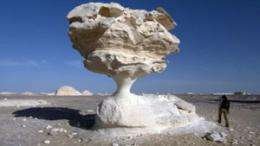
"When I initially landed in the Sahara, I was struck by how totally desolate it was, similar to the shading green was expelled from the palette when they made this place, simply nothing, grays and tans, and not a piece of life," Jennifer Smith says toward the start of a History TV channel narrative on the Sahara.
Smith, Ph.D., relate teacher of earth and planetary sciences in Arts and Sciences at Washington University in St. Louis, is setting up an amazing disclosure: The completely dry Sahara we know today shrouds a wet, periodically dribbling wet, geologic past. Actually, there are as yet goliath aquifers underneath the sand that hold as much crisp water as the Great Lakes.
So the Sahara is a land puzzle. To make sense of what happened and why, Smith and her associates must take after a trail of doubtful pieces of information that incorporate marine fossils in the pyramids, fossil whales in a remote aqueduct, or dry valley, Saharan sand in profound sea centers, and depictions in betray holes of individuals swimming.
Smith's claim to fame is geoarchaeology, which utilizes great earth science strategies and ideas to address inquiries of archeological intrigue. She is especially intrigued by the atmosphere in North Africa amid the previous couple of hundred thousand years, when it appears to have rotated amongst savannah and forsake. Her work proposes, in addition to other things, that intermittent muggy conditions all through the Sahara may have empowered the development of present day people out of Africa to Europe and Asia.
The narrative affectation Jan. 19 at 12:00 p.m. also, again at 6 p.m CST.
In the primary segment of the narrative, some portion of the History (some time ago The History Channel) arrangement "How the Earth was Made," Smith takes the watchers to the Great pyramid of Giza, where she indicates them old marine fossils called nummulites, a modest type of the Latin nummulus signifying "little coin," inserted in the obstructs that make up the pyramids.
Where did these marine fossils originate from?
Smith next takes the watchers to Wadi al-Hitan (Valley of the Whales) where the stones are an indistinguishable age from those from which the pyramid pieces were quarried. There she demonstrates the watchers the fossil skeleton of a 21-foot whale. The channel has a surprisingly high centralization of fossils, and every one of them are marine creatures.
What are whales doing in the abandon?
In the wake of uncovering the bewildering answer to that inquiry, Smith and her partners set off to illuminate two more Saharan riddles: when, precisely, did the Sahara turn into a forsake, and why, after that disastrous occasion, has it swayed amongst prairie and no man's land generally like clockwork?
The last swing of the pendulum, which occurred around 5,500 years back, is especially powerful in light of the fact that agriculturists had settled parts of the then green Sahara. They scratched into the mass of a Libyan give in a cloud releasing long dashes of rain. Be that as it may, this supplication in stone went unheard and unanswered - the downpours fizzled, and the general population vanished.
Toward the finish of the film, Smith takes the watcher to see pumping stations that are drawing water from the goliath aquifers underneath the abandon to flood crops. She calls attention to that the water spilling from the pumps is warm. Earth's temperature increments with profundity in this way, without nearby volcanic movement, the water's temperature demonstrates it originates from profound underground, seventy five percent of a mile down or more profound.
This is fossil water, Smith says, that collected over at any rate the last 1 million years. In a few sections of the Egyptian abandon, wells may run dry in as meager as 100 years and, in light of the work she and her partners have done, it may be an additional 15,000 years previously they have an opportunity to refill.